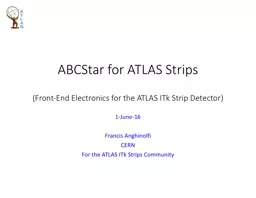PPT-ATLAS Silicon Tracker and BILPA
Author : haroublo | Published Date : 2020-07-02
Phil Allport Matt B aca James Broughton Andy Chisholm Laura Gonella Kostas Nikolopoulos Simon Pyatt Juergen Thomas John Wilson 300915 1 Introduction ATLAS UK
Presentation Embed Code
Download Presentation
Download Presentation The PPT/PDF document "ATLAS Silicon Tracker and BILPA" is the property of its rightful owner. Permission is granted to download and print the materials on this website for personal, non-commercial use only, and to display it on your personal computer provided you do not modify the materials and that you retain all copyright notices contained in the materials. By downloading content from our website, you accept the terms of this agreement.
ATLAS Silicon Tracker and BILPA: Transcript
Download Rules Of Document
"ATLAS Silicon Tracker and BILPA"The content belongs to its owner. You may download and print it for personal use, without modification, and keep all copyright notices. By downloading, you agree to these terms.
Related Documents



